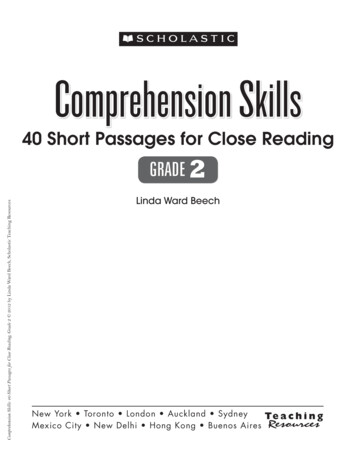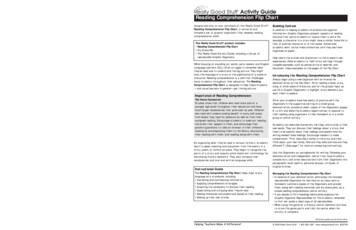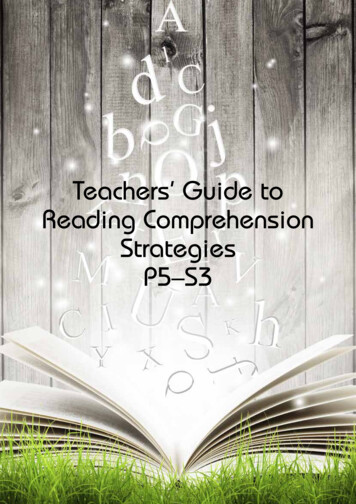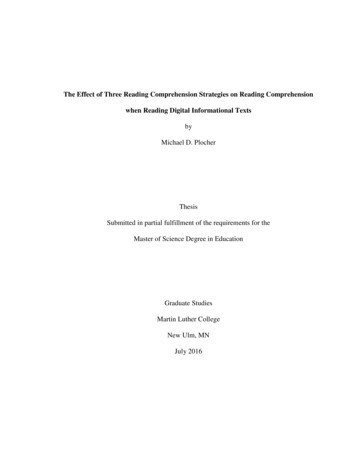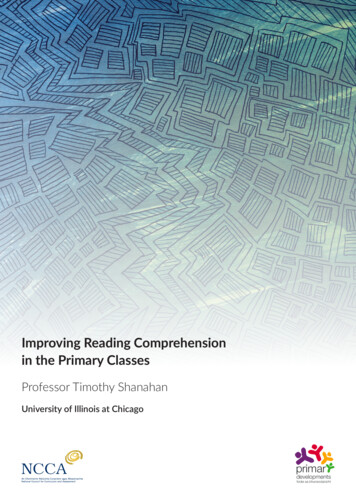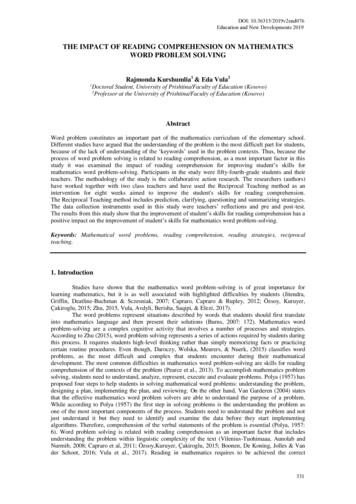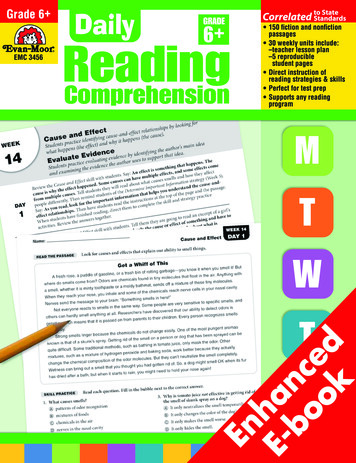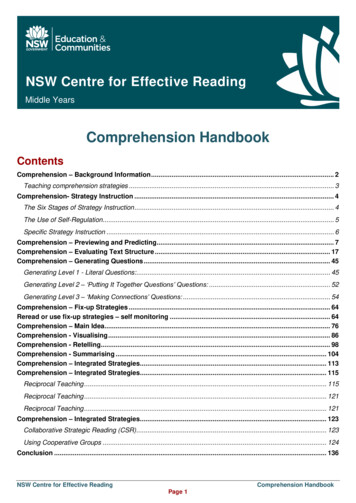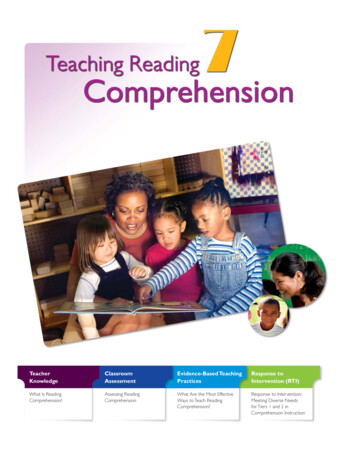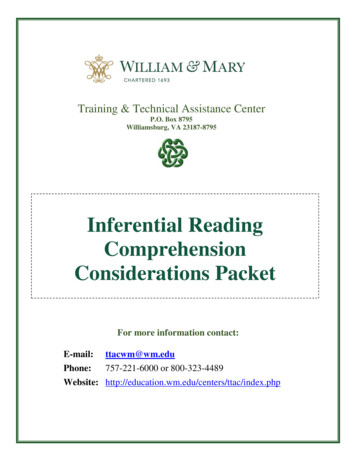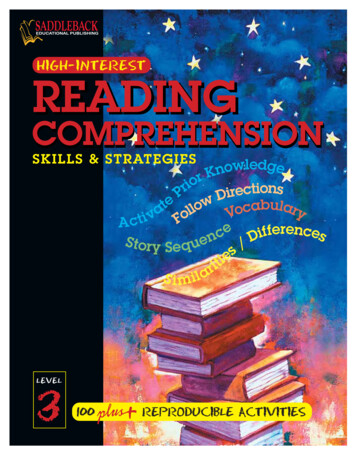
Transcription
HIGH-INTERESTSKILLS & Vv FoitcAeerencesfficDS t o r y S e q u en/seitiralS i miLEVEL3100REPRODUCIBLE ACTIVITIES
Reading ComprehensionSkills and StrategiesLevel 3Saddleback Educational PublishingThree WatsonIrvine, CA 92618-2767Web site: www.sdlback.comDevelopment and Production:The EDGeISBN 1-56254-030-0Copyright 2002 by Saddleback Educational Publishing. All rights reserved. No part of this book may be reproduced in anyform or by any means, electronic or mechanical, including photocopying, recording, or by any information storage andretrieval system, without written permission of the publisher, with the following exception.Pages labeled Saddleback Educational Publishing 2002 are intended for reproduction. Saddleback EducationalPublishing grants to individual purchasers of this book the right to make sufficient copies of reproducible pages for use by allstudents of a single teacher. This permission is limited to an individual teacher, and does not apply to entire schools orschool systems.Printed in the United States of America06 05 04 03 02 9 8 7 6 5 4 3 2 1
Table of ContentsSkillsTeacher welcome and teaching tips . . . . . . . . . . . . . 4Identifying familiar analogies . . . . . . . . . . . . . . . . . 33Analyzing word structure—synonyms . . . . . . . . . . . . 6Identifying familiar analogies . . . . . . . . . . . . . . . . . 34Analyzing word structure—antonyms . . . . . . . . . . . . 7Identifying unfamiliar analogies . . . . . . . . . . . . . . 35Analyzing word structure—synonyms andantonyms . . . . . . . . . . . . . . . . . . . . . . . . . . . . . . . . 8Identifying unfamiliar analogies . . . . . . . . . . . . . . 36Analyzing word structure—base words . . . . . . . . . . . 9Interpreting a Venn diagram . . . . . . . . . . . . . . . . . . 38Analyzing word structure—base words . . . . . . . . . . 10Interpreting a Venn diagram . . . . . . . . . . . . . . . . . . 39Analyzing word structure—word origins . . . . . . . . . 11Interpreting idiom phrases . . . . . . . . . . . . . . . . . . . 40Analyzing word structure—base words & prefixes . 12Interpreting figures of speech . . . . . . . . . . . . . . . . . 41Analyzing word structure—suffixes . . . . . . . . . . . . . 13Recognizing the 5 W’s . . . . . . . . . . . . . . . . . . . . . . . 42Analyzing word structure—suffixes . . . . . . . . . . . . . 14Recognizing the 5 W’s . . . . . . . . . . . . . . . . . . . . . . . 43Analyzing vocabulary using visual andcontext clues . . . . . . . . . . . . . . . . . . . . . . . . . . . . . 15Predictions of what will happen next . . . . . . . . . . . 44Analyzing vocabulary using visual andcontext clues . . . . . . . . . . . . . . . . . . . . . . . . . . . . . 16Reading the table of contents . . . . . . . . . . . . . . . . . 46Categorizing information . . . . . . . . . . . . . . . . . . . . 37Predictions of what will happen next . . . . . . . . . . . 45Using the index to preview content . . . . . . . . . . . . . 47Analyzing vocabulary using visual andcontext clues . . . . . . . . . . . . . . . . . . . . . . . . . . . . . 17Using headings and captions to previewand predict content . . . . . . . . . . . . . . . . . . . . . . . 48Analyzing vocabulary using visual andcontext clues . . . . . . . . . . . . . . . . . . . . . . . . . . . . . 18Using headings and captions to previewand predict content . . . . . . . . . . . . . . . . . . . . . . . 49Analyzing vocabulary using visual andcontext clues . . . . . . . . . . . . . . . . . . . . . . . . . . . . . 19Analyzing vocabulary using context clues . . . . . . . 20Making a movie in your mind topreview and predict content . . . . . . . . . . . . . . . . . 50Analyzing vocabulary—multiple-meaningwords . . . . . . . . . . . . . . . . . . . . . . . . . . . . . . . . . . . 21Using illustrations and graphic devices topredict content . . . . . . . . . . . . . . . . . . . . . . . . . . . 51Analyzing vocabulary—multiple-meaningwords . . . . . . . . . . . . . . . . . . . . . . . . . . . . . . . . . . . 22Reading the cover of a book to predict content . . . 52Analyzing vocabulary—multiple-meaningwords . . . . . . . . . . . . . . . . . . . . . . . . . . . . . . . . . . . 23Concentrating on the details of an adto make decisions . . . . . . . . . . . . . . . . . . . . . . . . . 54Analyzing vocabulary—multiple-meaningwords . . . . . . . . . . . . . . . . . . . . . . . . . . . . . . . . . . . 24Comparing reviews before makinga decision . . . . . . . . . . . . . . . . . . . . . . . . . . . . . . . 55Analyzing vocabulary—signal words . . . . . . . . . . . 25Comparing and contrasting details . . . . . . . . . . . . 56Analyzing vocabulary—signal words . . . . . . . . . . . 26Identifying topic and supporting sentences . . . . . . 57Analyzing vocabulary—context clues in text . . . . . 27Identifying problem/solution . . . . . . . . . . . . . . . . . . 58Following directions . . . . . . . . . . . . . . . . . . . . . . . . . 28Identifying supporting details . . . . . . . . . . . . . . . . . 59Following directions . . . . . . . . . . . . . . . . . . . . . . . . . 29Reading for details . . . . . . . . . . . . . . . . . . . . . . . . . . 60Following directions using a graphic device . . . . . . 30Interpreting a chart . . . . . . . . . . . . . . . . . . . . . . . . . 61Identifying nouns in text . . . . . . . . . . . . . . . . . . . . . 31Interpreting labels . . . . . . . . . . . . . . . . . . . . . . . . . . 62Categorizing a list of items in text . . . . . . . . . . . . . 32Interpreting labels . . . . . . . . . . . . . . . . . . . . . . . . . . 63Reading the video case to predict content . . . . . . . 532
Interpreting a timeline/graphingstory events . . . . . . . . . . . . . . . . . . . . . . . . . . . . . . 64Identifying the author’s view/purpose . . . . . . . . . 101Identifying the author’s purpose . . . . . . . . . . . . . . 102Interpreting an economic graphic device . . . . . . . . 65Identifying the character’s view . . . . . . . . . . . . . . . 103Interpreting a Venn diagram . . . . . . . . . . . . . . . . . . 66Evaluating story events . . . . . . . . . . . . . . . . . . . . . 104Developing a Venn diagram of your own . . . . . . . . 67Sequencing events . . . . . . . . . . . . . . . . . . . . . . . . . 105Interpreting a nutrition matrix . . . . . . . . . . . . . . . . 68Critical thinking (own conclusions) . . . . . . . . . . . 106Interpreting a superhero matrix . . . . . . . . . . . . . . . 69Critical thinking (own conclusions) . . . . . . . . . . . 107Distinguishing fact/opinion . . . . . . . . . . . . . . . . . . . 70Critical thinking (own conclusions) . . . . . . . . . . . 108Distinguishing fact/exaggeration . . . . . . . . . . . . . . 71Critical thinking (own conclusions) . . . . . . . . . . . 109Deleting trivial and redundant information . . . . . . 72Identifying main character(s) . . . . . . . . . . . . . . . . 110Deleting trivial and redundant information . . . . . . 73Identifying setting . . . . . . . . . . . . . . . . . . . . . . . . . 111Sequencing story events . . . . . . . . . . . . . . . . . . . . . . 74Identifying setting . . . . . . . . . . . . . . . . . . . . . . . . . 112Sequencing events . . . . . . . . . . . . . . . . . . . . . . . . . . 75Identifying time . . . . . . . . . . . . . . . . . . . . . . . . . . . 113Sequencing story events . . . . . . . . . . . . . . . . . . . . . . 76Identifying time . . . . . . . . . . . . . . . . . . . . . . . . . . . 114Sequencing story events . . . . . . . . . . . . . . . . . . . . . . 77Identifying main idea . . . . . . . . . . . . . . . . . . . . . . 115Sequencing using a timeline . . . . . . . . . . . . . . . . . . 78Identifying main idea . . . . . . . . . . . . . . . . . . . . . . 116Retelling a story . . . . . . . . . . . . . . . . . . . . . . . . . . . . 79Identifying plot . . . . . . . . . . . . . . . . . . . . . . . . . . . . 117Retelling a story . . . . . . . . . . . . . . . . . . . . . . . . . . . . 80Planning a plot . . . . . . . . . . . . . . . . . . . . . . . . . . . 118Identifying a topic sentence . . . . . . . . . . . . . . . . . . . 81Predicting outcome . . . . . . . . . . . . . . . . . . . . . . . . 119Identifying a topic sentence . . . . . . . . . . . . . . . . . . . 82Predicting outcome . . . . . . . . . . . . . . . . . . . . . . . . 120Identifying supporting sentences . . . . . . . . . . . . . . . 83Making a generalization . . . . . . . . . . . . . . . . . . . . 121Creating supporting details and facts . . . . . . . . . . . 84Identifying tone/mood . . . . . . . . . . . . . . . . . . . . . . 122Creating supporting sentences . . . . . . . . . . . . . . . . 85Identifying tone/mood . . . . . . . . . . . . . . . . . . . . . . 123Identifying supporting sentences . . . . . . . . . . . . . . . 86Interpreting a graph . . . . . . . . . . . . . . . . . . . . . . . 124Identifying cause and effect . . . . . . . . . . . . . . . . . . . 87Interpreting a graph . . . . . . . . . . . . . . . . . . . . . . . 125Identifying cause and effect . . . . . . . . . . . . . . . . . . . 88Recalling factual details . . . . . . . . . . . . . . . . . . . . . 126Identifying similarities and differences . . . . . . . . . . 89Recalling factual details . . . . . . . . . . . . . . . . . . . . . 127Identifying similarities and differences . . . . . . . . . . 90Mapping story events . . . . . . . . . . . . . . . . . . . . . . . 128Analyzing characters . . . . . . . . . . . . . . . . . . . . . . . . 91Mapping story events . . . . . . . . . . . . . . . . . . . . . . . 129Analyzing character attributes . . . . . . . . . . . . . . . . 92Mapping story events . . . . . . . . . . . . . . . . . . . . . . . 130Analyzing data . . . . . . . . . . . . . . . . . . . . . . . . . . . . . 93Mapping story events . . . . . . . . . . . . . . . . . . . . . . . 131Analyzing data . . . . . . . . . . . . . . . . . . . . . . . . . . . . . 94Interpreting a timeline . . . . . . . . . . . . . . . . . . . . . . 132Predicting outcomes . . . . . . . . . . . . . . . . . . . . . . . . . 95Mapping story details . . . . . . . . . . . . . . . . . . . . . . 133Predicting outcomes . . . . . . . . . . . . . . . . . . . . . . . . . 96Mapping story details . . . . . . . . . . . . . . . . . . . . . . 134Making inferences . . . . . . . . . . . . . . . . . . . . . . . . . . 97Identifying author’s purpose . . . . . . . . . . . . . . . . . 135Making inferences . . . . . . . . . . . . . . . . . . . . . . . . . . 98Practicing good writing . . . . . . . . . . . . . . . . . . . . . 136Making inferences . . . . . . . . . . . . . . . . . . . . . . . . . . 99Teacher’s Scope and Sequence chart . . . . . . . . . . . 137Identifying the author’s view/purpose . . . . . . . . . 100Answer Key . . . . . . . . . . . . . . . . . . . . . . . . . . . . . . . 1393
Teacher Pages just for you!Welcome to Reading ComprehensionSkills and StrategiesAbout this SeriesThis unique series is specially created for you by Saddleback Educational Publishing,as an exciting supplement to reinforce and extend your classroom reading curriculum.Reading Comprehension Skills and Strategies can easily be integrated into basic readingcurricula as additional reading lessons: as stand-alone strategy and skill instructionallessons; as across-the-curriculum lessons; or as activities for students with specialprojects, interests, or abilities.This series is based on the most current research and thought concerning the teachingof reading comprehension. This series not only sharpens traditional readingcomprehension skills, but also reinforces the critical reading comprehension strategiesthat encourage your students to use prior knowledge, experiences, careful thought,and evaluation to help them decide how to practically apply what they know to allreading situations.Traditional comprehension skills recently have been woven into the larger context ofstrategy instruction. Today, literacy instruction emphasizes learning strategies—thoseapproaches that coordinate the various reading and writing skills and prior knowledgeto make sense to the learner. Our goal in this series is to provide you and yourstudents with the most up-to-date reading comprehension support, while teachingbasic skills that can be tested and evaluated.Reading Comprehension Strategies vocabulary knowledgeactivating prior knowledgepre-reading—previewing and predictingpreviewing and predicting textmental imagingself-questioningsummarizingsemantic mappingSaddleback Educational Publishing promotes the development of the whole child withparticular emphasis on combining solid skill instruction with creativity andimagination. This series gives your students a variety of opportunities to apply readingcomprehension strategies as they read, while reinforcing basic reading comprehensionskills. In addition, we designed this series to help you make an easy transition betweenlevels (grades 2, 3, and 4) in order to reinforce or enhance needed skill development forindividual students.4
About this BookReading Comprehension Skills and Strategies is designed to reinforce and extend thereading skills of your students. The fun, high-interest fiction and non-fictionselections will spark the interest of even your most reluctant reader. The book offersyour students a variety of reading opportunities—reading for pleasure, reading togather information, and reading to perform a task. A character on each pageprompts the student to apply one of the strategies to the reading selection which islinked to a relevant comprehension skill activity.Choosing Instructional ApproachesYou can use the pages in this book for independent reinforcement or extension,whole group lessons, pairs, or small cooperative groups rotating through anestablished reading learning center. You may choose to place the activities in acenter and reproduce the answer key for self-checking. To ensure the utmostflexibility, the process for managing this is left entirely up to you because youknow what works best in your classroom.AssessmentAssessment and evaluation of student understanding and ability is an ongoingprocess. A variety of methods and strategies should be used to ensure that thestudent is being assessed and evaluated in a fair and comprehensive manner.Always keep in mind that the assessment should take into consideration theopportunities the student had to learn the information and practice the skillspresented. The strategies for assessment are left for you to determine and aredependent on your students and your particular instructional plan. You will find aScope and Sequence Chart at the back of this book to assist you as you developyour assessment plan.5
Synonyms are words that have the same or nearlythe same meaning. So, tap into what you know(about words) and give it a go!Directions:Select a synonym for the underlined word in the sentences from the Word Bank.Write the synonym on the line.kWord ll1.Dad is picking me up from school today.2.The twins keep their bedroom very clean.3.Maria ran across the road.4.The baby became ill at day care.5.Will you speak to my teacher?6.The picture hung above the fireplace.7.The huge bird landed on our deck.8.Please place the plate on the table.9.Four errors were marked on my test.10.Let’s order a little pan-size pizza.Name:Reading Comprehension Saddleback Educational Publishing 20026Date:3 Watson, Irvine, CA 92618 Phone(888)SDL-BACK www.sdlback.com
Hey, did you know that antonyms are words thathave opposite meanings? Use what you know aboutopposites to complete this activity. Have fun!Directions:Read the rhymes. Something is wrong—they don’t rhyme. Change themby writing the correct antonyms of the underlined words. Use the WordBank and then read the rhymes again.Word Bankheadplaymoonhumwetstayaroundnightquietsweet1. I always choose toys I can cuddle in bed.My favorite’s a bear with a bow on its foot.2. A playful monkey took my hat one day.I told him he could keep it if he’d go away and rest.3. How would it be to dance on the sun?I’d like to be first—can you think of a tune?4. At day by the campfire, I sing my best songs.If you don’t know the words you can just yell along.5. If I could choose an animal to take home for a pet,I would take a penguin, so loud and so dry.6. While walking in the city and not looking at my feet,I fell into a sewer where the smell was none too sour.Name:Reading Comprehension Saddleback Educational Publishing 20027Date:3 Watson, Irvine, CA 92618 Phone(888)SDL-BACK www.sdlback.com
Okay, so now you are an expert on synonyms andantonyms. Use what you’ve learned below.Directions: In each blank write the letter of the word that is a synonym or antonym of theunderlined word.AntonymsSynonyms1. Sue enjoyed the show.a. likedb. watchedc. disliked1. We climbed up narrow stairs.a. wideb. longc. tall2. Give me a clue.a. chanceb. prizec. hint2. That is not true.a. crazyb. falsec. sad3. Open the door.a. lockb. closec. unlock3. Ted will arrive later.a. todayb. soonerc. nearer4. Imagine you are a rock star.a. forgetb. pretendc. believe4. Nothing seems to fit.a. Somethingb. Everythingc. Anything5. My teacher sent the note.a. envelopeb. letterc. picture5. The ice felt smooth.a. slickb. wetc. roughName:Reading Comprehension Saddleback Educational Publishing 20028Date:3 Watson, Irvine, CA 92618 Phone(888)SDL-BACK www.sdlback.com
Always remember to ask yourself: What is thebase word? If you do that you will not have anyproblems with the activity below.Directions:A base word is a word from which other words are made. Write the baseof each word on the line.Example:shortshortest1. teacher11. flowers21. friendly2. helpful12. branches22. foolish3. clues13. braver23. repay4. artist14. numbers24. owner5. arrived15. unkind25. lowest6. laughed16. missed26. replace7. building17. trees27. tables8. longest18. smaller28. started9. asks19. voices29. shorter20. churches30. sleepy10. farmerName:Reading Comprehension Saddleback Educational Publishing 20029Date:3 Watson, Irvine, CA 92618 Phone(888)SDL-BACK www.sdlback.com
Always be on the lookout for base words.Directions:Read the story carefully. Then find the bold words and underline the base wordfor each. Finally, answer the questions.Zebras are among the most beautiful animals on earth. With their boldblack-and-white stripes, they stand apart from other African animals. Theyroam freely over the large African plains. Many people don’t know it, butthe zebra is one of the few wild horses left in the world today. All horsesbelong to the same animal group, known as Equus.Zebras are shorter than most other horses,their ears are larger, and some of them makea barking sound! Most importantly, onlyzebras have stripes—even their manes arestriped! Many zebras have been killed for theirbeautiful skins. Fortunately, things are beingdone to protect zebras now. African governments andwildlife groups have set up nature preserves, wherezebras can live without the risk of being hunted.1. Where do all the world’s wild zebras live?2. What is the animal group to which zebras belong?3. List three things you learned about zebras by reading the selection.4. How are people trying to help protect zebras?Name:Reading Comprehension Saddleback Educational Publishing 200210Date:3 Watson, Irvine, CA 92618 Phone(888)SDL-BACK www.sdlback.com
It’s really cool to learn about where words in theEnglish language came from. Have fun exploring!Directions:Write words from the lunch box to replace words in the story that arefrom Old English and other languages in ( ). Use each word only meltedbrushingoutMarina was dozing in and (ut) of sleep when she heard her Dad(giellan) , “Get up, now! You’re late for (skole) .”“Late?” shrieked Marina. He was (riht) . As she leapt out of bed,she glanced at the (clocca) . She had just eight minutes until thebus arrived. She quickly dressed, throwing on a T-shirt and sneakers. After(twisten) her hair into a quick knot and (broose)her teeth, she tore downstairs and headed toward the door.Dad handed her (boc) to her. He looked sorry. “We’re out ofcereal. Get some (milc) when you get to school,” he suggested.The bus pulled up and Marina sprinted over and hopped on. The only (saeti)left was next to Jarvis, who always smelled a bit like fried bacon.“Yuck,” she thought. As she sat down, she felt something weird and wriggledaround a bit. “Oh, no!” she cried to herself as she (meltan) intothe seat. She had forgotten to (taka) off her pajama bottoms. Itwas going to be one of those days.Name:Reading Comprehension Saddleback Educational Publishing 200211Date:3 Watson, Irvine, CA 92618 Phone(888)SDL-BACK www.sdlback.com
You, yes you, can unlock the meaning of hundredsof words by knowing the meaning of base wordsand prefixes.Directions:The prefix un means “not.” Read the story, then add the un prefix to the underlinedwords to change the meaning of the story. Finally, read the story again.It sounds amazing and a bit real, but this tale has been passed down froma very long time ago. I am certain where it came from, but it does notmake me happy to tell it again to you. So here goes.In a land far away there was an happy, grateful, and altogether crankytroll named Rolf. He hated just about everything! He thought all rules werenecessary and that school was boring. He thought all the other trollchildren and even his teacher were friendly. He even hated recess! One dayat recess the troll children were picking teams forkickball. They had an equal number ofplayers on each team. Of course, the only trollnot on a team was Rolf. So the troll childreneasily asked kind and predictableRolf to join their team. Well, the rest, as theysay, is history. That day Rolf brought in thewinning run for his team. Rolf changed froman lucky and loved little troll into ahappy and friendly troll.Name:Reading Comprehension Saddleback Educational Publishing 200212Date:3 Watson, Irvine, CA 92618 Phone(888)SDL-BACK www.sdlback.com
Do you know that suffixes are groups of lettersadded to the end of words and they can changethe meaning of the word?Directions:Read the first sentence in each set. It gives you the base word. In the second andthird sentences add the suffixes from the Suffix Box to create new meanings forthe base words.lyness itiesSuffix Boxen est eryingitionYou may use these more than one time.A.1. The boy is quiet.2. The boy sits quiet .3. The quiet was not disturbed.B.1. My grandpa is active and does many things.2. Grandpa has many fun activ that he enjoys, like golf.3. He always active tries new things.C.1. I have a new light in my bedroom.2. The yellow paint on the walls of my room really help light it up.3. I put my favorite teddy bear light on my pillows.D.1. The knight was very brave.2. He was the brav in the castle.3. He even got a medal for brav .E.1. Math is my favorite subject. I love to add and subtract.2. You’ll find me add up things all the time.3. My teacher thinks I’m a great add to her classroom.Name:Reading Comprehension Saddleback Educational Publishing 200213Date:3 Watson, Irvine, CA 92618 Phone(888)SDL-BACK www.sdlback.com
Use what you already know about base words andsuffixes to create new words below.Directions:Add the suffix ly, er, or ing to a base word on the towel to complete eachsentence. Remember, if a word ends in e, take off the e before adding itchbathuse1. In months, our skin dries out more .2. and are common problems.3. In the winter, your skin gently is important.4. is important, but not more than once a day.5. After just pat your skin dry. Don’t rub it dry.6. Take bath or showers.7. Avoid itchy fabrics next to your skin.8. lots of water will help.9. lotion helps also.10. Keep the heat in your house nothan 70 degrees.11. Go to the doctor if your skin startsitching .Name:Reading Comprehension Saddleback Educational Publishing 200214Date:3 Watson, Irvine, CA 92618 Phone(888)SDL-BACK www.sdlback.com
Make a movie in your mind. Picture beautifulPuerto Rico as you read the selections below.Bon Voyage!Directions:Use the pictures and the words in each selection to answer the questions below.¡Hola Puerto Rico! Bordered by the Atlantic Ocean and theCaribbean Sea, Puerto Rico, with its rich Hispanic heritage,is America’s premier 100-mile-long island territory. ThePuerto Ricans are self-governed U.S. citizens.Hey! Try this trick to remember the name of the capital of PuertoRico. Imagine you are walking along a sandy beach and you finda magic wand. You pick up the wand and wave it over the sandand NOTHING! So much for sand and wands! Well, use this“picture” to remember that San Juan is the capital of Puerto Rico.Did you know that treasure ships once sailed the water nearPuerto Rico? Their hulls were filled with gold as they headedfor Spain. Some of them sank in storms off the coast of PuertoRico. They are still there, somewhere, and treasure hunters areon the lookout.The skies over Puerto Rico can send down buckets of rain,and then be clear and completely dry 15 minutes later. InPuerto Rico’s El Yunque rainforest, you can see a storm onone mountain and clear skies over a nearby mountain.1. What two large bodies of water border Puerto Rico?2. What is the capital of Puerto Rico?3. Where were the treasure ships that sailed from the Caribbean headed?4. What is the weather like in Puerto Rico?5. Is Puerto Rico a state, a country, or a territory island of the U.S.?6. What is the heritage of the Puerto Rican people?Name:Reading Comprehension Saddleback Educational Publishing 200215Date:3 Watson, Irvine, CA 92618 Phone(888)SDL-BACK www.sdlback.com
Hey, did you know that you can use pictures andcaptions to figure out new words in a selection beforeyou read?Directions:Look at the picture, read the caption, and read the selection.Then answer the questions ElbowjointPelvicgirdleYou have 206 bones in your body. Both boys andgirls have the same number of bones. Theymake up the framework, or skeleton, thatsupports the tissues and muscles. Your bones areimportant because of the structure they provideand also because of what they contain. Togetherthey give your body shape, and—moved by yourmuscles—help you to run after a ball, take awalk, or type a letter to your mom. They protectdelicate body parts. They also store bone marrowto produce blood cells and contain importantminerals like calcium and phosphorus that canbe released into your blood.1. Where can you find the humerus bone?FemurKnee jointKneecap(patella)2. What is the longest bone in your body andwhere is it located?3. Your kneecap has a special name. What is it?Tibia4. Your skeleton is the framework of your body.What does framework mean?5. Bones also give you calcium and phosphorus.These are a few of the bones in thebody. The femur is the longest bone.Can you find it on your body?What are those things?Name:Reading Comprehension Saddleback Educational Publishing 200216Date:3 Watson, Irvine, CA 92618 Phone(888)SDL-BACK www.sdlback.com
Use what you know and ask yourself questionsas you figure out this article.Directions:Read the paragraph without stopping to figure out the missing words. Now readit again and write the number of the missing word in the blank. Watch out!There are three extra words you won’t need.1.2.3.4.5.6. over7. five8. need9. players10. winnergymIf you like tennis, then you’ll badminton. This was named after anEnglish duke’s estate where the game was first . To play badminton, youa net, a lightweight racket, and a small ball with feathers, sometimes calleda “birdie.” The game is played two to four players, either indoors oroutdoors on a marked-out area, or court. The net is stretched across the ofthe court to a height of feet. The players the birdie back and forthover the net with the rackets. A is scored when the side that served thebirdie causes the receiving side to miss sending it back the net. A game isusually played to 15 points. A badminton match consists of winning two ofthree games. Badminton became an official Olympic sport at the 1992Olympic Games Barcelona, Spain.Not so fast, sports fan! Read it one moretime to be sure your answers make sense.Name:Reading Comprehension Saddleback Educational Publishing 200217Date:3 Watson, Irvine, CA 92618 Phone(888)SDL-BACK www.sdlback.com
Check out the pictures, names, and the wordsin the clues.Directions:Read each paragraph and answer the questions.1. You can find me in the forest and swamps of South America.Three large powerful claws on each front foot make it easy torip apart nests of termites and ants.My two-foot long snake-like tongue is coated with gummysaliva so that ants and termites will stick to it. Mmm, yummy!tarantulaWhat am I?2. My home is a burrow in the soil.I love to eat small frogs, toads, and mice, mainly at night.I am dark-colored with a hairy body and legs.mountain lionWhat am I?3. I live alone and eat only meat.My strong, muscular legs help me leap distances of morethan 20 feet.Some of my many names are: puma, cougar, and panther.What am I?coyote4. I hunt at night and store what I kill in the branches of a tree.Lions, tigers, and jaguars belong to the same animalfami
comprehension strategies as they read, while reinforcing basic reading comprehension skills. In addition, we designed this series to help you make an easy transition between levels (grades 2, 3, and 4) in order to reinforce or
